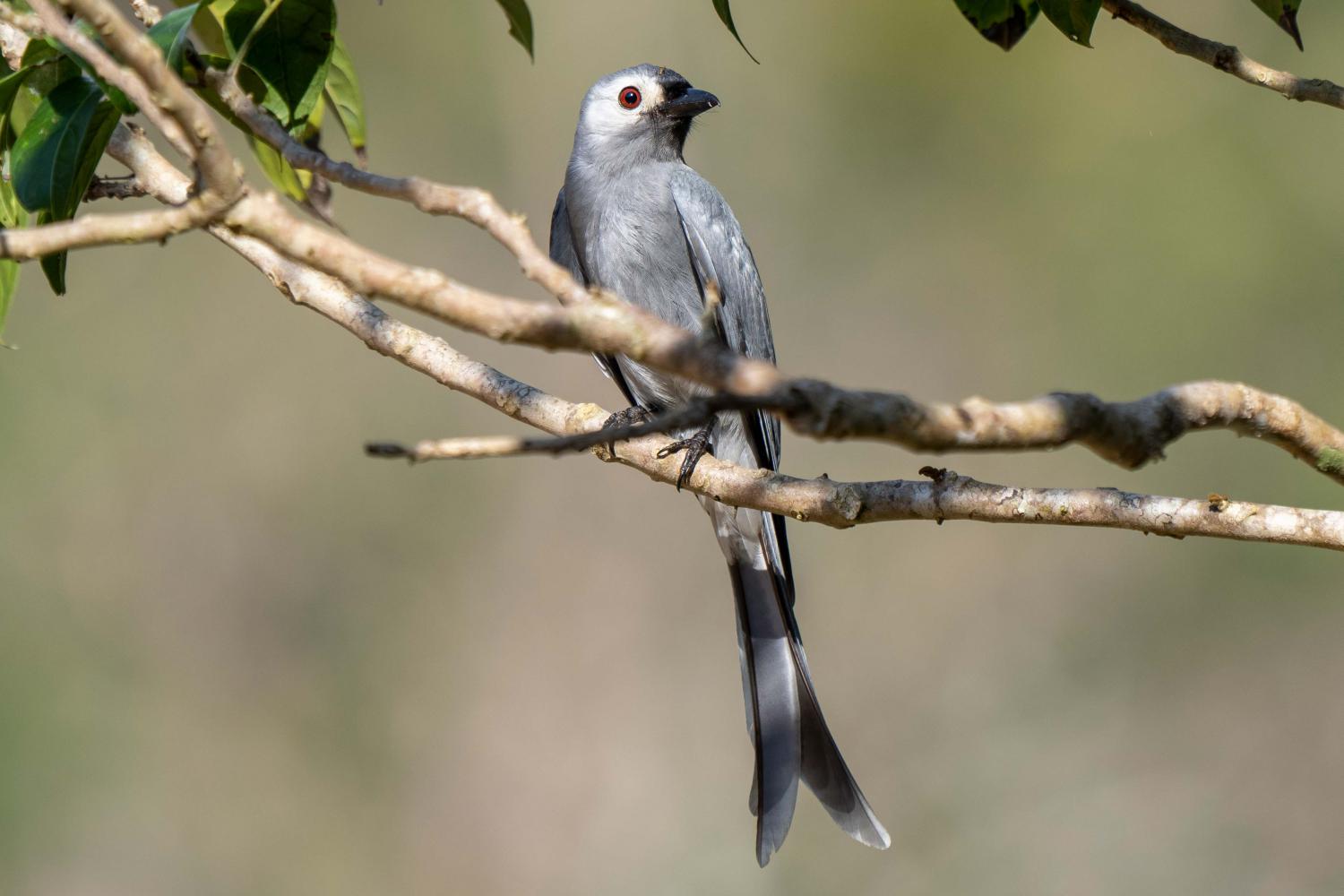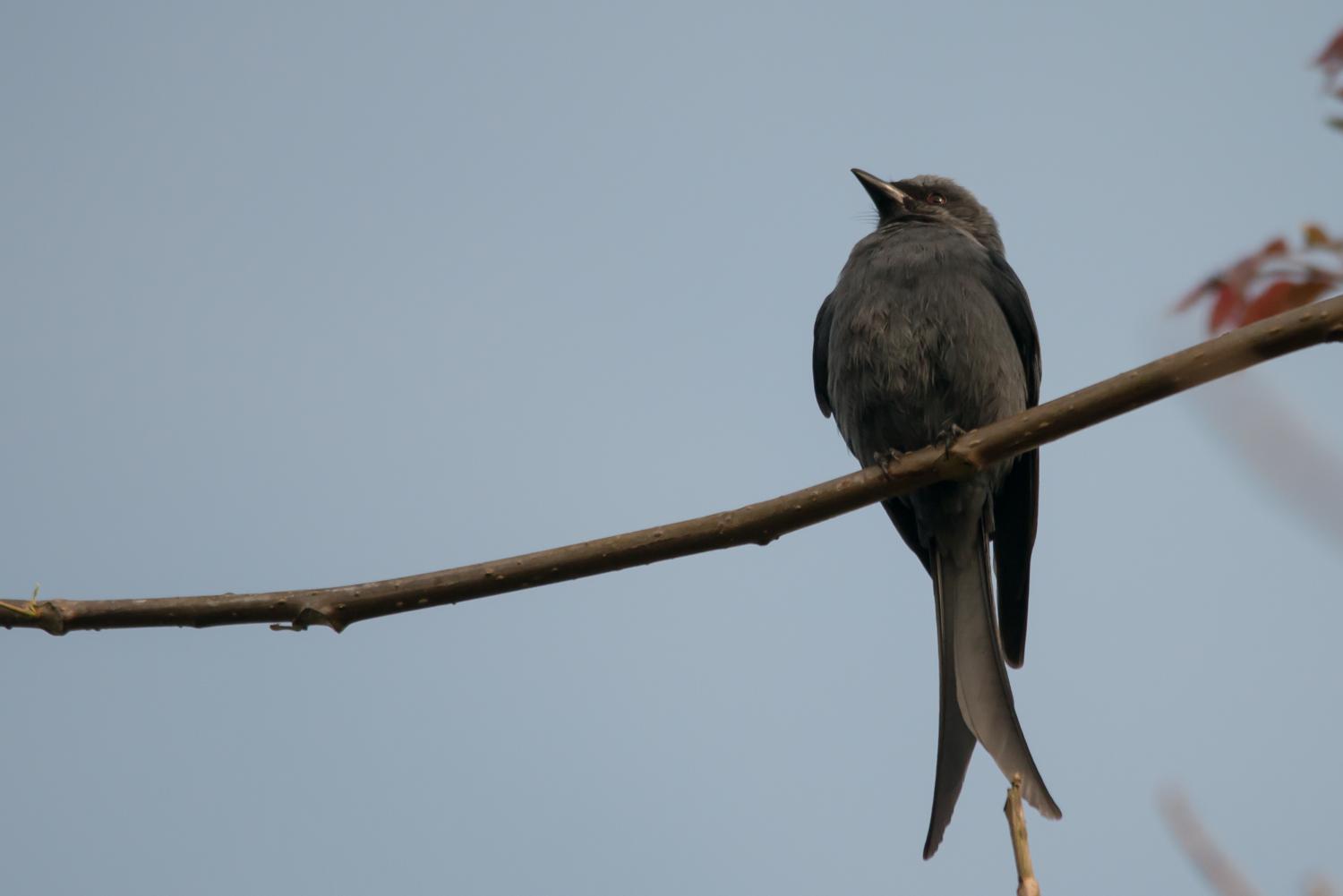Species of Thailand
Ashy drongo
Dicrurus leucophaeus
Louis Jean Pierre Vieillot, 1817
In Thai: นกแซงแซวสีเทา
The ashy drongo (Dicrurus leucophaeus) is a species of bird in the drongo family Dicruridae. It is found widely distributed across South and Southeast Asia with several populations that vary in the shade of grey, migration patterns and in the size or presence of white patches around the eye.
Description
The adult ashy drongo is mainly dark grey, and the tail is long and deeply forked, There are a number of subspecies varying in the shade of the grey plumage. Some subspecies have white markings on the head. Young birds are dull brownish grey.
Subspecies longicaudatus of India (which includes beavani of the Himalayas that winters on the peninsula, with one breeding population in central India that Vaurie separates as longicaudatus in the restricted sense) is very dark and almost like the black drongo although this bird is slimmer and has a somewhat longer and less-splayed tail. It is found in more tall forest habitat, has dark grey underside lacking the sheen of black drongo. The iris is crimson and there is no white rictal spot. Subspecies leucogenis and salangensis have a white eye-patch as do several of the island forms that breed further south. The calls are a little more nasal and twangy than that of the black drongo.
,
Distribution
The ashy drongo breeds in the hills of tropical southern Asia from eastern Afghanistan east to southern China, Ryukyu Islands in southern Japan (particularly Okinawa) and Indonesia. Many populations in the northern part of its range are migratory. Charles Vaurie described subspecies beavani (after Robert Cecil Beavan) as the population that breeds along the Himalayas that wintered in peninsular India. However, later workers include this as part of longicaudatus which also has a population that breeds in central India. In winter, the species is particularly fond of hill forests. E. C. Stuart Baker described stevensi which Vaurie considered as being either beavani or hopwoodi of the eastern Himalayas. To the east of the range of hopwoodi is mouhouti of Thailand and Myanmar. To the north of this range are leucogenis and salangensis (both migratory mainly to areas further south but also known from Nagaland) while bondi is found to the south. Along the southeast Asian island chain, there are number of insular populations including periophthalmus, ryukyuensis, batakensis, phaedrus, siberu and nigrescens. The nominate form is said to be found on Simalur, Java, Bali, Lombok, Palawan, and Balabac Islands.
Behaviour and ecology
The ashy drongo has short legs and sits very upright while perched prominently, often high on a tree. It is insectivorous and forages by making aerial sallies but sometimes gleans from tree trunks. They are found singly, in pairs or small groups. During migration they fly in small flocks.
A common call that they make is described as drangh gip or gip-gip-drangh. They can imitate the calls of other birds and are capable of imitating the whistling notes of a common iora.
The breeding season is May to June with a clutch of three or four reddish or brown eggs laid in a loose cup nest in a tree.
This article uses material from Wikipedia released under the Creative Commons Attribution-Share-Alike Licence 3.0. Eventual photos shown in this page may or may not be from Wikipedia, please see the license details for photos in photo by-lines.
Category / Seasonal Status
Wiki listed status (concerning Thai population): Resident and winter visitor
BCST Category: Recorded in an apparently wild state within the last 50 years
BCST Seasonal statuses:
- Resident or presumed resident
- Non-breeding visitor
Scientific classification
- Kingdom
- Animalia
- Phylum
- Chordata
- Class
- Aves
- Order
- Passeriformes
- Family
- Dicruridae
- Genus
- Dicrurus
- Species
- Dicrurus leucophaeus
Common names
- Thai: นกแซงแซวสีเทา
Conservation status

Least Concern (IUCN3.1)
Photos
Please help us review the bird photos if wrong ones are used. We can be reached via our contact us page.
Range Map

- Amphawa District, Samut Songkhram
- Ang Thong National Marine Park
- Ao Phang-Nga National Park
- Ban Bueng District, Chonburi
- Ban Laem District, Phetchaburi
- Ban Phai District, Khon Kaen
- Ban Pho District, Chachoengsao
- Ban Sang District, Prachinburi
- Bang Lamung District, Chonburi
- Bang Pa In District, Phra Nakhon Si Ayutthaya
- Bang Pahan District, Phra Nakhon Si Ayutthaya
- Bang Phra Non-Hunting Area
- Bang Pu Recreation Centre
- Bang Saphan Noi District, Prachuap Khiri Khan
- Bangkok Province
- Bueng Boraped Non-Hunting Area
- Bueng Khong Long Non-Hunting Area
- Chae Son National Park
- Chaloem Phra Kiat District, Saraburi
- Chaloem Phrakiat Thai Prachan National Park
- Chaloem Rattanakosin National Park
- Chiang Dao District, Chiang Mai
- Chiang Dao Wildlife Sanctuary
- Chiang Khong District, Chiang Rai
- Chiang Saen District, Chiang Rai
- Dan Sai District, Loei
- Doi Chong National Park
- Doi Inthanon National Park
- Doi Khun Tan National Park
- Doi Lang
- Doi Lo District, Chiang Mai
- Doi Pha Hom Pok National Park
- Doi Phu Kha National Park
- Doi Saket District, Chiang Mai
- Doi Suthep - Pui National Park
- Dong Kheng Forest Park
- Erawan National Park
- Fang District, Chiang Mai
- Hala-Bala Wildlife Sanctuary
- Hang Chat District, Lampang
- Hat Chao Mai National Park
- Hat Wanakon National Park
- Hua Hin District, Prachuap Khiri Khan
- Huai Chorakhe Mak Reservoir Non-Hunting Area
- Huai Kha Khaeng Wildlife Sanctuary
- Huai Nam Dang National Park
- In Buri District, Sing Buri
- Kabin Buri District, Prachinburi
- Kaeng Khoi District, Saraburi
- Kaeng Krachan District, Phetchaburi
- Kaeng Krachan National Park
- Kaeng Krung National Park
- Kamphaeng Saen District, Nakhon Pathom
- Kanthararom District, Sisaket
- Kantharawichai District, Maha Sarakham
- Kaset Sombun District, Chaiyaphum
- Khao Ang Rue Nai Wildlife Sanctuary
- Khao Banthat Wildlife Sanctuary
- Khao Chamao - Khao Wong National Park
- Khao Dinsor (Chumphon Raptor Center)
- Khao Khiao - Khao Chomphu Wildlife Sanctuary
- Khao Khitchakut National Park
- Khao Laem National Park
- Khao Laem Ya - Mu Ko Samet National Park
- Khao Lak - Lam Ru National Park
- Khao Luang National Park
- Khao Nam Khang National Park
- Khao Nang Phanthurat Forest Park
- Khao Phra - Bang Khram Wildlife Sanctuary
- Khao Sam Roi Yot National Park
- Khao Sanam Prieng Wildlife Sanctuary
- Khao Soi Dao Wildlife Sanctuary
- Khao Sok National Park
- Khao Yai National Park
- Khao Yoi District, Phetchaburi
- Khlong Lan National Park
- Khlong Luang District, Pathum Thani
- Khlong Phanom National Park
- Khlong Wang Chao National Park
- Khon San District, Chaiyaphum
- Khun Chae National Park
- Khun Korn Forest Park
- Khun Nan National Park
- Khun Phawo National Park
- Khun Tan District, Chiang Rai
- Khung Kraben Non-Hunting Area
- Khura Buri District, Phang Nga
- Klaeng District, Rayong
- Ko Chang National Park
- Ko Samui District, Surat Thani
- Ko Sichang District, Chonburi
- Kromluang Chumphon Wildlife Sanctuary
- Kui Buri National Park
- Kumphawapi District, Udon Thani
- Laem Ngop District, Trat
- Laem Pak Bia
- Laem Son National Park
- Lam Nam Kok National Park
- Lan Sang National Park
- Mae Ai District, Chiang Mai
- Mae Chan District, Chiang Rai
- Mae Fa Luang District, Chiang Rai
- Mae Mo District, Lampang
- Mae Moei National Park
- Mae Ping National Park
- Mae Rim District, Chiang Mai
- Mae Sai District, Chiang Rai
- Mae Sot District, Tak
- Mae Taeng District, Chiang Mai
- Mae Tha, Lampang District, Lampang
- Mae Wong National Park
- Mancha Khiri District, Khon Kaen
- Mueang Chiang Mai District, Chiang Mai
- Mueang Chiang Rai District, Chiang Rai
- Mueang Chonburi District, Chonburi
- Mueang Chumphon District, Chumphon
- Mueang Kamphaeng Phet District, Kamphaeng Phet
- Mueang Kanchanaburi District, Kanchanaburi
- Mueang Khon Kaen District, Khon Kaen
- Mueang Krabi District, Krabi
- Mueang Lampang District, Lampang
- Mueang Lamphun District, Lamphun
- Mueang Lopburi District, Lopburi
- Mueang Maha Sarakham District, Maha Sarakham
- Mueang Nakhon Nayok District, Nakhon Nayok
- Mueang Nakhon Pathom District, Nakhon Pathom
- Mueang Nan District, Nan
- Mueang Nonthaburi District, Nonthaburi
- Mueang Pathum Thani District, Pathum Thani
- Mueang Phang Nga District, Phang Nga
- Mueang Phetchaburi District, Phetchaburi
- Mueang Phuket District, Phuket
- Mueang Prachinburi District, Prachinburi
- Mueang Ranong District, Ranong
- Mueang Ratchaburi District, Ratchaburi
- Mueang Rayong District, Rayong
- Mueang Samut Sakhon District, Samut Sakhon
- Mueang Satun District, Satun
- Mueang Sisaket District, Sisaket
- Mueang Songkhla District, Songkhla
- Mueang Sukhothai District, Sukhothai
- Mueang Suphanburi District, Suphan Buri
- Mueang Surin District, Surin
- Mueang Tak District, Tak
- Mueang Trat District, Trat
- Nam Nao National Park
- Nam Phong National Park
- Namtok Mae Surin National Park
- Namtok Phlio National Park
- Namtok Sam Lan National Park
- Nanthaburi National Park
- Nong Bong Khai Non-Hunting Area
- Nong Ya Plong District, Phetchaburi
- Op Khan National Park
- Pa Sang District, Lamphun
- Pai District, Mae Hong Son
- Pak Kret District, Nonthaburi
- Pak Phanang District, Nakhon Si Thammarat
- Pak Phli District, Nakhon Nayok
- Pak Thale
- Pang Sida National Park
- Pang Sila Thong District, Kamphaeng Phet
- Pha Daeng National Park
- Pha Hin Ngam National Park
- Pha Nam Yoi Forest Park
- Pha Taem National Park
- Phan District, Chiang Rai
- Phanat Nikhom District, Chonburi
- Phi Phi Islands
- Phimai District, Nakhon Ratchasima
- Phra Nakhon Si Ayutthaya District, Phra Nakhon Si Ayutthaya
- Phu Chi Fa Forest Park
- Phu Chong Na Yoi National Park
- Phu Foi Lom National Park
- Phu Hin Rong Kla National Park
- Phu Khiao Wildlife Sanctuary
- Phu Kradueng National Park
- Phu Langka National Park
- Phu Luang Wildlife Sanctuary
- Phu Pha Thoep National Park
- Phu Phan National Park
- Phu Ruea National Park
- Phu Sa Dok Bua National Park
- Phu Soi Dao National Park
- Phu Suan Sai National Park
- Phu Toei National Park
- Phu Wiang National Park
- Phutthamonthon District, Nakhon Pathom
- Pran Buri District, Prachuap Khiri Khan
- Pran Buri Forest Park
- Sai Noi District, Nonthaburi
- Sai Yok District, Kanchanaburi
- Sakaerat Environmental Research Station
- Salak Pra Wildlife Sanctuary
- Salawin National Park
- Samae San Island
- Samut Prakan Province
- San Sai District, Chiang Mai
- Sanam Bin Reservoir Non-Hunting Area
- Sanam Chai Khet District, Chachoengsao
- Sangkhla Buri District, Kanchanaburi
- Sathing Phra District, Songkhla
- Sattahip District, Chonburi
- Si Racha District, Chonburi
- Si Satchanalai District, Sukhothai
- Si Satchanalai National Park
- Si Sawat District, Kanchanaburi
- Sikao District, Trang
- Sirinat National Park
- Sri Nakarin Dam National Park
- Sri Phang-nga National Park
- Ta Phraya National Park
- Tai Rom Yen National Park
- Taksin Maharat National Park
- Takua Pa District, Phang Nga
- Taphan Hin District, Phichit
- Tat Mok National Park
- Tha Phae District, Satun
- Tha Takiap District, Chachoengsao
- Tha Yang District, Phetchaburi
- Thai Mueang District, Phang Nga
- Thalang District, Phuket
- Than Sadet - Koh Pha-Ngan National Park
- Thanyaburi District, Pathum Thani
- Thap Lan National Park
- Thong Pha Phum National Park
- Thung Salaeng Luang National Park
- Thung Yai Naresuan Wildlife Sanctuary
- Umphang Wildlife Sanctuary
- Wang Chan District, Rayong
- Wang Mai Forest Restoration Project
- Wat Phai Lom & Wat Ampu Wararam Non-Hunting Area
- Wiang Kaen District, Chiang Rai
- Wiang Lo Wildlife Sanctuary


